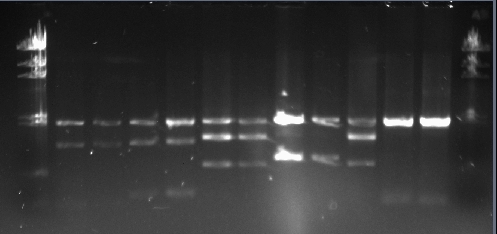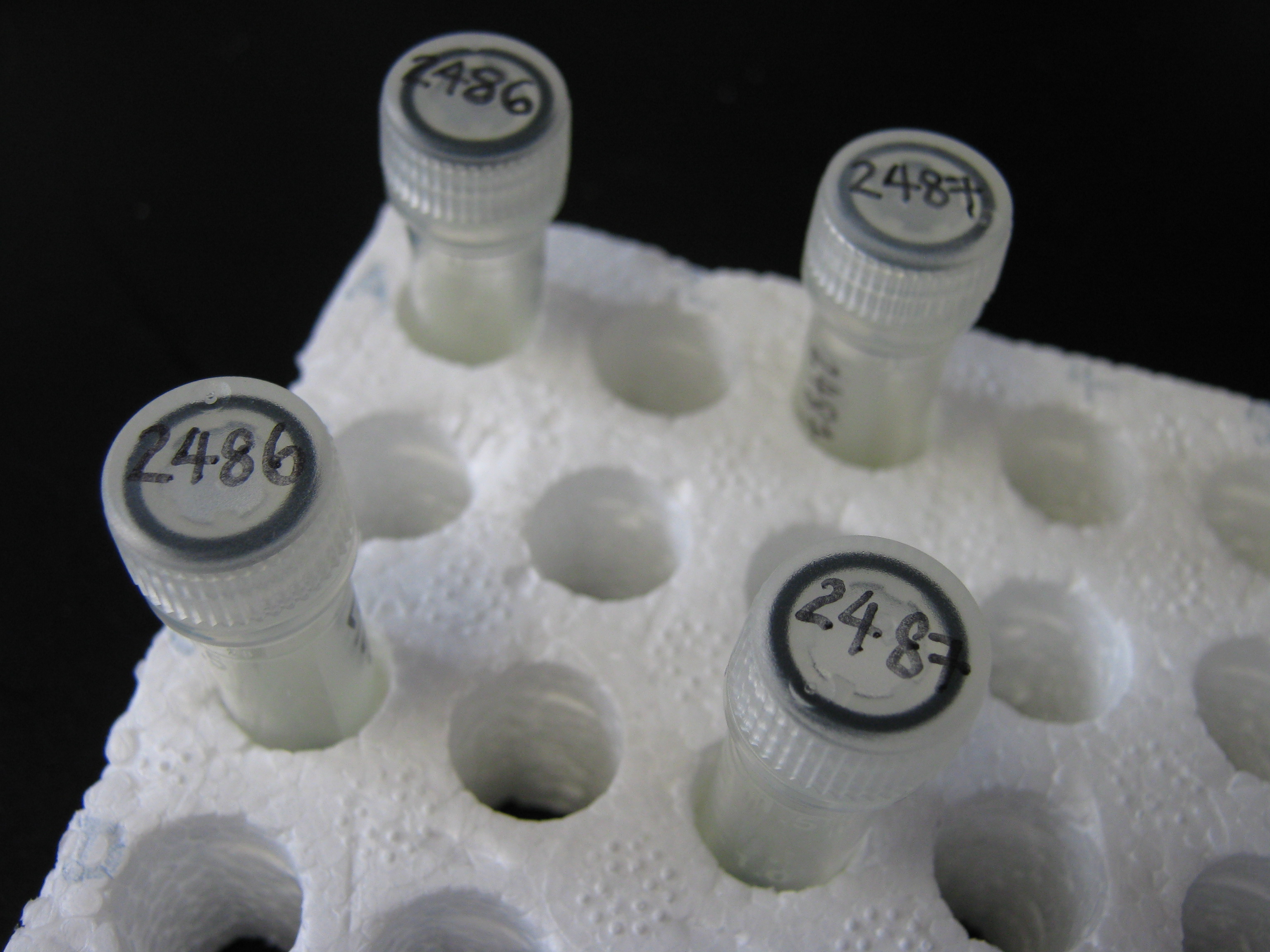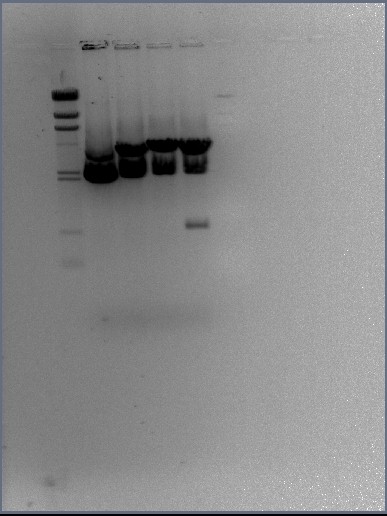Formal Lab Session - 26th August 2009
Overview
- Stochastic Switch Team - carried out the restriction digests on the mini-preps reattempted yesterday (except for BBa_C0178)
- Metal Sensor Team - digested BBa_J33206 midi-preps and analysed them through DNA gel electrophoresis
Stochastic Switch Team
Summary

Jess and Goksel working on the restriction digests
Today Lab started at 2pm, so we had the afternoon to do restriction digests for the remaining biobricks(other than C0178). Out of 12 cultures, 11 of them were grown. We used the fast digest system, which takes 5 minutes in a 37 degree waterbath rather than 60 minutes. Below are the volumes required for a double digest using EcoRI and PstI:
- 6ul water
- 2ul 10X Fast digest buffer
- 1ul of fast digest EcoRI enzyme
- 1ul of fast digest PstI enzyme
- 10ul DNA (miniprepped)
Total volume: 20ul
These were left for 5-10 minutes at 37 degrees, then 9ul of the total volume was added to 1ul of loading buffer, and the samples were run on the gel we prepared yesterday.
Running the gel

Jess innoculating 3ml of LB with
DH5-alpha E.coli cells
We loaded the samples in the following order. all he biobricks had pSB1A2 as the plasmid backbone which is 2079bp long.
| Sample
| Location
| Length
|
| LuxR promoter
| 2,3
| 55bp
|
| LasR promoter
| 4,5
| 157bp
|
| LuxI CDS
| 6,7
| 585bp
|
| LasR CDS
| 8,9
| 723bp
|
| LasI
| 10
| 609
|
| HixC
| 11,12
| 26bp
|

The bands at the bottom of the gel reflects the lengths of the biobricks truly.
However, in some wells there are three bands although we used two restriction enzymes and there should have been two bands for each. This might due to using the fast digest enzymes and not waiting long enough before running the gel.
We had run the gel for LasI using normal enzymes and had seen only two bands before.
Today we also prepared some overnight cultures of DH5alpha cells (2X 3ml plain LB) for the Genomic DNA prep which will be carried out tomorrow.
Metal Sensor Team
Introduction

Mathew pipetting digested
pSB1A2 plasmid containing the BioBrick
BBa_J33206 into gel
Yesterday's lab session saw a few things happen: 1)We prepared the 'products' of a PCR reaction on the genome of Bacillus subtilis transformed with pGFP-rrnB and put it through gel electrophoresis, 2)The midi-prep samples stored in the freezer underwent ethanol precipitation and DNA concentration and 3) Agarose gel was made up for restriction enzyme digests (to be done today). Time ran out quickly and this prevented the team from performing the other tasks. We hope to complete the tasks in today's lab session.
Today, the Metal Sensing team intend to digest some samples of BBa_J33206 in pSB1A2 with enzymes EcoRI and PstI and run both them and an undigested sample on gel. The results of this experiment will determine our next moves.
Practical Outline

Jane helping the Metal Sensing Team with lab housekeeping during waiting times
The following list consists of the tasks the Metal Sensing team hope to achieve by the end of the day:
- Carry out the restiction enzyme digests of the midi-prep plasmid DNA (pSB1A2 containing BioBrick BBa_J33206) and run them on the gel.
- Carry out the genomic DNA preparations.
Procedure
Restriction enzyme digests of the midi-prep DNA
It was decided that four samples would be prepared from our midi-prep stock of the BBa_J33206 BioBrick in plasmid pSB1A2 DNA. The four samples include sample DNA on it's own (uncut plasmid), sample DNA + EcoRI, plasmid + PstI and finally plasmid + EcoRI + PstI (should yield the plasmid backbone and BioBrick insert).
The protocol we used was one suggested by FastDigest, the company from which our restriction enzymes came from.
The contents of the digest samples are as follows:
Contents of the four samples of BBa_J33206 in pSB1A2 plasmid
| | pSB1A2 alone | pSB1A2 + EcoRI | pSB1A2 + PstI | pSB1A2 + EcoRI + PstI
|
| DNA (ul)
| 10 | 10 | 10 | 10
|
| Restriction Buffer (ul)
| 2 | 2 | 2 | 2
|
| Restriction Enzyme(ul)
| 0 | 1 | 1 | 2
|
| Distilled water(ul)
| 8 | 7 | 7 | 6
|
The benefit of using FastDigest enzymes is that they only take 5 minutes to digest the DNA samples! To be certain that the DNA samples are cut correctly, the time given under incubation for the enzymes to digest the DNA was 10 minutes. After this time, the digests and the undigested sample were run on the gel
DNA gel electrophoresis of digests
The digest samples were treated in the way the DNA gel electrophoresis protocol suggested - 9ul of digest DNA was taken from each of the four tubes and to each, 1ul of loading buffer (dye) was added. 10ul of the samples were then added to the wells (located in between the HindIII DNA ladder filled wells) in the following order:
- Lane 1 = blank
- Lane 2 = 8ul of HindIII DNA ladder
- Lane 3 = 10ul of pSB1A2 alone
- Lane 4 = 10ul of pSB1A2 + EcoRI
- Lane 5 = 10ul of pSB1A2 + PstI
- Lane 6 = 10ul of pSB1A2 + EcoRI + PstI
- Lane 7 = 8ul of HindIII DNA ladder
The DNA gel electrophoresis was run at 90v and run for 30 minutes. The results and analysis of the gel can be seen below in the 'Results' section
Results
It is quite clear from this photograph that the restriction digests did not work properly. Whilst it looks like the plasmid backbones are the right size (we are expecting the backbone to be 2079bp and on the gel it appears to be between 1904 and 3530bp), their appearance looks unconvincing. All four plasmid backbones appear to have been split into two parts; this should not happen at all. The samples treated with only one enzyme should be linearised not cut into two parts whereas in the sample treated with both enzymes, the backbone should be in one piece with the insert removed.
It has to be noted that the insert appears smaller than expected; according to the Parts Registry the BBa_J33206 BioBrick is 956bp whereas the gel photograph suggests it's roughly 564bp long.
The suggested reasons for this are:
- Too much DNA was added to the wells - this can be seen by the heavy black blots on the photograph
- The FastDigest enzymes EcoRI and PstI were given too little time to act.
In another attempt of this restriction enzyme digest, the Metal Sensor team should consider altering the amount of contents in the restriction enzyme digest mix and should also consider reviewing the length of incubation time allowed for the digests to happen as well as how much DNA to put into the wells.
Promoter Library Sub-Project
The aim of this sub-project is to create a library of sigA promoters which differ in strength and to characterise them.
The first step in this process is to digest the pGFP-rrnb plasmid with restriction enzymes EcoRI and NheI. The enzyme digests were prepared in 1 Eppendorf tube in the following way:
- 15ul of pGFP-rrnb plasmid DNA (from a midiprep)
- 3ul NheI (FastDigest)
- 3ul EcoRI (FastDigest)
- 4ul FastDigest buffer
- 15ul distilled water
This makes up a total volume of 40ul The mixture was made in such a way that the DNA, the distilled water and the FastDigest buffer was added first before the enzymes were added. The tube was given a spin pulse and placed in a water bath at 37C for 1 hour.
After this the mixture was placed in the -20C freezer for use tomorrow.
In the meantime, 0.8% agarose gel was prepared in the usual way and poured into the gel tray. The only difference between this gel and others previously poured is that some of the comb was taped so that the wells formed were larger. Once the gel had set, 1xTAE buffer was sprinkled onto the surface and the gel wrapped up in cling film. The gel was placed in the fridge also for use tomorrow.
| July
|
| M | T | W | T | F | S | S
|
|
|
| [http://2009.igem.org/wiki/index.php?title=Team:Newcastle/Labwork/1_July_2009&action=edit 1]
| [http://2009.igem.org/wiki/index.php?title=Team:Newcastle/Labwork/2_July_2009&action=edit 2]
| [http://2009.igem.org/wiki/index.php?title=Team:Newcastle/Labwork/3_July_2009&action=edit 3]
| [http://2009.igem.org/wiki/index.php?title=Team:Newcastle/Labwork/4_July_2009&action=edit 4]
| [http://2009.igem.org/wiki/index.php?title=Team:Newcastle/Labwork/5_July_2009&action=edit 5]
|
| [http://2009.igem.org/wiki/index.php?title=Team:Newcastle/Labwork/6_July_2009&action=edit 6]
| [http://2009.igem.org/wiki/index.php?title=Team:Newcastle/Labwork/7_July_2009&action=edit 7]
| [http://2009.igem.org/wiki/index.php?title=Team:Newcastle/Labwork/8_July_2009&action=edit 8]
| [http://2009.igem.org/wiki/index.php?title=Team:Newcastle/Labwork/9_July_2009&action=edit 9]
| [http://2009.igem.org/wiki/index.php?title=Team:Newcastle/Labwork/10_July_2009&action=edit 10]
| [http://2009.igem.org/wiki/index.php?title=Team:Newcastle/Labwork/11_July_2009&action=edit 11]
| [http://2009.igem.org/wiki/index.php?title=Team:Newcastle/Labwork/12_July_2009&action=edit 12]
|
| [http://2009.igem.org/wiki/index.php?title=Team:Newcastle/Labwork/13_July_2009&action=edit 13]
| [http://2009.igem.org/wiki/index.php?title=Team:Newcastle/Labwork/14_July_2009&action=edit 14]
| [http://2009.igem.org/wiki/index.php?title=Team:Newcastle/Labwork/15_July_2009&action=edit 15]
| [http://2009.igem.org/wiki/index.php?title=Team:Newcastle/Labwork/16_July_2009&action=edit 16]
| [http://2009.igem.org/wiki/index.php?title=Team:Newcastle/Labwork/17_July_2009&action=edit 17]
| [http://2009.igem.org/wiki/index.php?title=Team:Newcastle/Labwork/18_July_2009&action=edit 18]
| [http://2009.igem.org/wiki/index.php?title=Team:Newcastle/Labwork/19_July_2009&action=edit 19]
|
| [http://2009.igem.org/wiki/index.php?title=Team:Newcastle/Labwork/20_July_2009&action=edit 20]
| [http://2009.igem.org/wiki/index.php?title=Team:Newcastle/Labwork/21_July_2009&action=edit 21]
| [http://2009.igem.org/wiki/index.php?title=Team:Newcastle/Labwork/22_July_2009&action=edit 22]
| [http://2009.igem.org/Team:Newcastle/Labwork/23_July_2009 23]
| [http://2009.igem.org/Team:Newcastle/Labwork/24_July_2009 24]
| [http://2009.igem.org/wiki/index.php?title=Team:Newcastle/Labwork/25_July_2009&action=edit 25]
| [http://2009.igem.org/wiki/index.php?title=Team:Newcastle/Labwork/26_July_2009&action=edit 26]
|
| [http://2009.igem.org/Team:Newcastle/Labwork/27_July_2009 27]
| [http://2009.igem.org/Team:Newcastle/Labwork/28_July_2009 28]
| [http://2009.igem.org/Team:Newcastle/Labwork/29_July_2009 29]
| [http://2009.igem.org/Team:Newcastle/Labwork/30_July_2009 30]
| [http://2009.igem.org/Team:Newcastle/Labwork/31_July_2009 31]
|
|
| August
|
| M | T | W | T | F | S | S
|
|
|
|
|
|
| [http://2009.igem.org/wiki/index.php?title=Team:Newcastle/Labwork/1_August_2009&action=edit 1]
| [http://2009.igem.org/wiki/index.php?title=Team:Newcastle/Labwork/2_August_2009&action=edit 2]
|
| [http://2009.igem.org/wiki/index.php?title=Team:Newcastle/Labwork/3_August_2009&action=edit 3]
| [http://2009.igem.org/Team:Newcastle/Labwork/4_August_2009 4]
| [http://2009.igem.org/Team:Newcastle/Labwork/5_August_2009 5]
| [http://2009.igem.org/wiki/index.php?title=Team:Newcastle/Labwork/6_August_2009&action=edit 6]
| [http://2009.igem.org/Team:Newcastle/Labwork/7_August_2009 7]
| [http://2009.igem.org/wiki/index.php?title=Team:Newcastle/Labwork/8_August_2009&action=edit 8]
| [http://2009.igem.org/wiki/index.php?title=Team:Newcastle/Labwork/9_August_2009&action=edit 9]
|
| [http://2009.igem.org/Team:Newcastle/Labwork/10_August_2009 10]
| [http://2009.igem.org/Team:Newcastle/Labwork/11_August_2009 11]
| [http://2009.igem.org/Team:Newcastle/Labwork/12_August_2009 12]
| [http://2009.igem.org/Team:Newcastle/Labwork/13_August_2009 13]
| [http://2009.igem.org/Team:Newcastle/Labwork/14_August_2009 14]
| [http://2009.igem.org/wiki/index.php?title=Team:Newcastle/Labwork/15_August_2009&action=edit 15]
| [http://2009.igem.org/wiki/index.php?title=Team:Newcastle/Labwork/16_August_2009&action=edit 16]
|
| [http://2009.igem.org/Team:Newcastle/Labwork/17_August_2009 17]
| [http://2009.igem.org/Team:Newcastle/Labwork/18_August_2009 18]
| [http://2009.igem.org/Team:Newcastle/Labwork/19_August_2009 19]
| [http://2009.igem.org/Team:Newcastle/Labwork/20_August_2009 20]
| [http://2009.igem.org/Team:Newcastle/Labwork/21_August_2009 21]
| [http://2009.igem.org/wiki/index.php?title=Team:Newcastle/Labwork/22_August_2009&action=edit 22]
| [http://2009.igem.org/wiki/index.php?title=Team:Newcastle/Labwork/23_August_2009&action=edit 23]
|
| [http://2009.igem.org/Team:Newcastle/Labwork/24_August_2009 24]
| [http://2009.igem.org/Team:Newcastle/Labwork/25_August_2009 25]
| [http://2009.igem.org/Team:Newcastle/Labwork/26_August_2009 26]
| [http://2009.igem.org/Team:Newcastle/Labwork/27_August_2009 27]
| [http://2009.igem.org/Team:Newcastle/Labwork/28_August_2009 28]
| [http://2009.igem.org/wiki/index.php?title=Team:Newcastle/Labwork/29_August_2009&action=edit 29]
| [http://2009.igem.org/wiki/index.php?title=Team:Newcastle/Labwork/30_August_2009&action=edit 30]
|
| [http://2009.igem.org/wiki/index.php?title=Team:Newcastle/Labwork/31_August_2009&action=edit 31]
|
|
| September
|
| M | T | W | T | F | S | S
|
|
| [http://2009.igem.org/Team:Newcastle/Labwork/1_September_2009 1]
| [http://2009.igem.org/Team:Newcastle/Labwork/2_September_2009 2]
| [http://2009.igem.org/Team:Newcastle/Labwork/3_September_2009 3]
| [http://2009.igem.org/Team:Newcastle/Labwork/4_September_2009 4]
| [http://2009.igem.org/wiki/index.php?title=Team:Newcastle/Labwork/5_September_2009&action=edit 5]
| [http://2009.igem.org/wiki/index.php?title=Team:Newcastle/Labwork/6_September_2009&action=edit 6]
|
| [http://2009.igem.org/Team:Newcastle/Labwork/7_September_2009 7]
| [http://2009.igem.org/Team:Newcastle/Labwork/8_September_2009 8]
| [http://2009.igem.org/Team:Newcastle/Labwork/9_September_2009 9]
| [http://2009.igem.org/Team:Newcastle/Labwork/10_September_2009 10]
| [http://2009.igem.org/Team:Newcastle/Labwork/11_September_2009 11]
| [http://2009.igem.org/wiki/index.php?title=Team:Newcastle/Labwork/12_September_2009&action=edit 12]
| [http://2009.igem.org/wiki/index.php?title=Team:Newcastle/Labwork/13_September_2009&action=edit 13]
|
| [http://2009.igem.org/Team:Newcastle/Labwork/14_September_2009 14]
| [http://2009.igem.org/Team:Newcastle/Labwork/15_September_2009 15]
| [http://2009.igem.org/Team:Newcastle/Labwork/16_September_2009 16]
| [http://2009.igem.org/Team:Newcastle/Labwork/17_September_2009 17]
| [http://2009.igem.org/Team:Newcastle/Labwork/18_September_2009 18]
| [http://2009.igem.org/wiki/index.php?title=Team:Newcastle/Labwork/19_September_2009&action=edit 19]
| [http://2009.igem.org/wiki/index.php?title=Team:Newcastle/Labwork/20_September_2009&action=edit 20]
|
| [http://2009.igem.org/Team:Newcastle/Labwork/21_September_2009 21]
| [http://2009.igem.org/Team:Newcastle/Labwork/22_September_2009 22]
| [http://2009.igem.org/Team:Newcastle/Labwork/23_September_2009 23]
| [http://2009.igem.org/Team:Newcastle/Labwork/24_September_2009 24]
| [http://2009.igem.org/Team:Newcastle/Labwork/25_September_2009 25]
| [http://2009.igem.org/wiki/index.php?title=Team:Newcastle/Labwork/26_September_2009&action=edit 26]
| [http://2009.igem.org/wiki/index.php?title=Team:Newcastle/Labwork/27_September_2009&action=edit 27]
|
| [http://2009.igem.org/Team:Newcastle/Labwork/28_September_2009 28]
| [http://2009.igem.org/Team:Newcastle/Labwork/29_September_2009 29]
| [http://2009.igem.org/Team:Newcastle/Labwork/30_September_2009 30]
|
|
| October
|
| M | T | W | T | F | S | S
|
|
|
|
| [http://2009.igem.org/Team:Newcastle/Labwork/1_October_2009 1]
| [http://2009.igem.org/Team:Newcastle/Labwork/2_October_2009 2]
| [http://2009.igem.org/wiki/index.php?title=Team:Newcastle/Labwork/3_October_2009&action=edit 3]
| [http://2009.igem.org/wiki/index.php?title=Team:Newcastle/Labwork/4_October_2009&action=edit 4]
|
| [http://2009.igem.org/Team:Newcastle/Labwork/5_October_2009 5]
| [http://2009.igem.org/Team:Newcastle/Labwork/6_October_2009 6]
| [http://2009.igem.org/Team:Newcastle/Labwork/7_October_2009 7]
| [http://2009.igem.org/Team:Newcastle/Labwork/8_October_2009 8]
| [http://2009.igem.org/Team:Newcastle/Labwork/9_October_2009 9]
| [http://2009.igem.org/wiki/index.php?title=Team:Newcastle/Labwork/10_October_2009&action=edit 10]
| [http://2009.igem.org/wiki/index.php?title=Team:Newcastle/Labwork/11_October_2009&action=edit 11]
|
| [http://2009.igem.org/Team:Newcastle/Labwork/12_October_2009 12]
| [http://2009.igem.org/Team:Newcastle/Labwork/13_October_2009 13]
| [http://2009.igem.org/Team:Newcastle/Labwork/14_October_2009 14]
| [http://2009.igem.org/Team:Newcastle/Labwork/15_October_2009 15]
| [http://2009.igem.org/Team:Newcastle/Labwork/16_October_2009 16]
| [http://2009.igem.org/wiki/index.php?title=Team:Newcastle/Labwork/17_October_2009&action=edit 17]
| [http://2009.igem.org/wiki/index.php?title=Team:Newcastle/Labwork/18_October_2009&action=edit 18]
|
| [http://2009.igem.org/wiki/index.php?title=Team:Newcastle/Labwork/19_October_2009&action=edit 19]
| [http://2009.igem.org/wiki/index.php?title=Team:Newcastle/Labwork/20_October_2009&action=edit 20]
| [http://2009.igem.org/wiki/index.php?title=Team:Newcastle/Labwork/21_October_2009&action=edit 21]
| [http://2009.igem.org/wiki/index.php?title=Team:Newcastle/Labwork/22_October_2009&action=edit 22]
| [http://2009.igem.org/wiki/index.php?title=Team:Newcastle/Labwork/23_October_2009&action=edit 23]
| [http://2009.igem.org/wiki/index.php?title=Team:Newcastle/Labwork/24_October_2009&action=edit 24]
| [http://2009.igem.org/wiki/index.php?title=Team:Newcastle/Labwork/25_October_2009&action=edit 25]
|
| [http://2009.igem.org/wiki/index.php?title=Team:Newcastle/Labwork/26_October_2009&action=edit 26]
| [http://2009.igem.org/wiki/index.php?title=Team:Newcastle/Labwork/27_October_2009&action=edit 27]
| [http://2009.igem.org/wiki/index.php?title=Team:Newcastle/Labwork/28_October_2009&action=edit 28]
| [http://2009.igem.org/wiki/index.php?title=Team:Newcastle/Labwork/29_October_2009&action=edit 29]
| [http://2009.igem.org/wiki/index.php?title=Team:Newcastle/Labwork/30_October_2009&action=edit 30]
| [http://2009.igem.org/wiki/index.php?title=Team:Newcastle/Labwork/31_October_2009&action=edit 31]
|
|
 "
"







